The translucency of acrylic paint makes for some stunning effects. But can cause issues when the artist needs them to be opaque. Over time I have found a few simple techniques that can be used to either create opaque colors or make them seem opaque while painting with acrylics.
You can make acrylic paint opaque by adding either white or colored opaque colors to your mix or underpainting with an opaque color. The type of paint that you use and how you layer can affect how opaque the paint is. In some instances, you can add a medium, or even layer to gain greater opacity.
While each of the methods mentioned above can all create opaque acrylic paint to some degree each one has its drawbacks and uses which I have detailed below. Along with more ideas to make your paint look, act, or seem opaque.
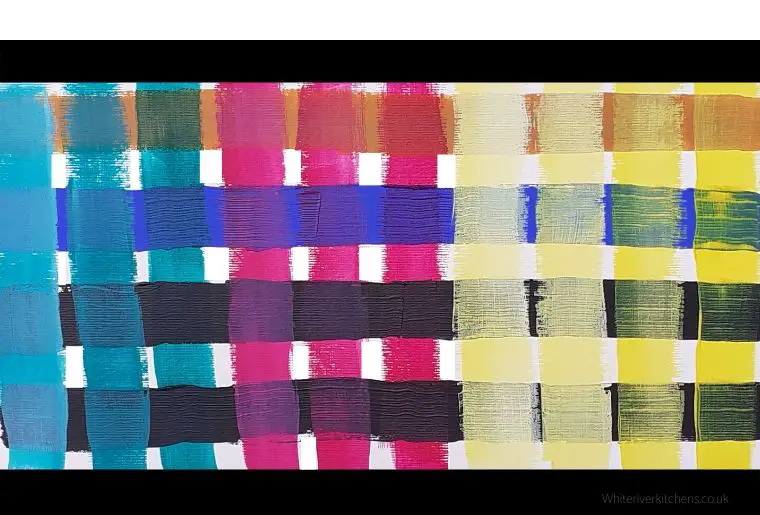
8 Easy Ways to Make Your Acrylic Paint Opaque
One of the things many artists want to know is how to make your acrylic paints opaque or at least how to make them more so. There are lots of ways to do this some actually make them opaque while others can give the illusion of opacity.
1 Mix Your Paint With White To Increase Opacity
I thought I’d start with one of the most used methods of making your acrylic paint opaque and that is to use white, specifically titanium white. While it’s tried and tested it is also open to a few issues. These are easily overcome with a bit of patience, practice, and know-how.
Titanium white is opaque. It is the most opaque of the whites. This means you can use it to increase the color’s opaqueness. This is a popular method amongst artists.
The main drawback of using white to make paint opaque is that it tints the color you are using. If you use too much of it, it changes the color completely and makes the color pastel.
Once the white is added to another color that color cannot be changed back no matter how many colors you use to offset the white. This means you have to know what effects adding white will have.
Basically, it creates a tint. If you have an artist’s color wheel, it will show you how adding white affects how your colors look.
Note: Make sure you are using titanium white and not zinc mixing white as the mixing white is not (normally) opaque. It’s usually transparent. I am caveating this statement though as although this is normally the case with most brands mine is actually opaque. So double-check when you buy it. It should say in the description and on the tube/bottle.

As you can see from the examples above adding white helps to make your colors opaque. Note the green is much more intense and a deeper green than it looks here
For the examples in this article, I chose to use 3 colors from different parts of the color wheel. These colors are also different brands. I did this so you could see how the same rules apply to each brand.
- Phthalo Green (transparent) – Artelier
- Quinacridone violet (transparent) – Winsor and Newton Artist Color
- Lemon Yellow (transparent) – System 3
Each of these colors is painted over two types of black, my cobalt blue and yellow ochre. All of these paints including my cobalt blue (yours may not be) are opaque.
From right to left the first bar of color is pure color with as little dilution as possible just enough of wet on the brush.
The 2nd bar is a small amount of white and the last bars are an increased amount of whites.
You can see from this example how adding white does affect both the transparency and the color, and how it interacts with the color below.
A way around this would be to mix white with your color and then go over it with another layer of your desired color without adding the white.
2 Use White Paint Under Your Colors
To give your transparent paint more strength paint under it with white.
While technically this method doesn’t make the paint itself opaque you can use an opaque color or opaque white underneath the transparent color you are layering. This gives the illusion of opacity as it stops the color underneath from influencing it.
I use this technique when I have a translucent color and I want it over a dark color. If you paint it straight on it disappears which can be really annoying. That or it takes on the color below and acts like you are mixing it. As you can see from the example below where the yellow painted over the blue becomes green and the pink becomes purple.
Where I’ve painted a layer of white the original three colors really stand out compared to just using them on the base color.
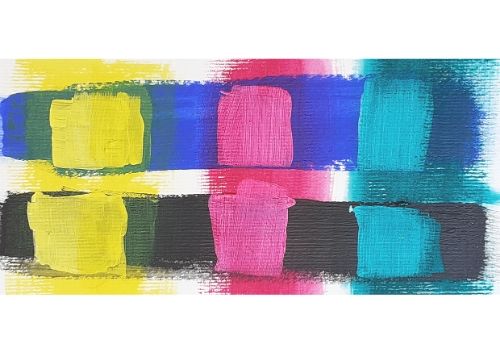
To do a layer like this follow these guidelines.
- Make sure your colored layer of paint is dry.
- Paint another layer of titanium opaque white only where you want to put your transparent color. Let the white dry.
- Next paint your color over the white.
3 Use Color To Make Opaque Paints
Another way to make your transparent colors opaque is to mix them with other opaque or semi-opaque colors either by mixing the two colors together or by painting a color underneath using the same methods as the white above in method 1.
Mixing Your Paint
You can use a similar technique with the color that you use with white. Use a transparent color with a semi-transparent or opaque color to increase the transparent color’s opaqueness.
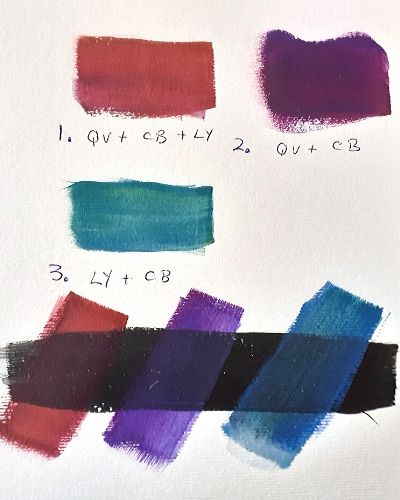
For this example, I have mixed together the following colors.
- Quinacridone violet (t) + Cobalt Blue (O) (again yours might not be opaque), and Lemon Yellow (t)
- Quinacridone violet (t) + Cobalt Blue (O)
- Lemon Yellow and cobalt blue
You can see when I place them over black they are much more opaque. Combine this with layering and you soon build up a strong color.
4 Can Mediums Work To Help Paint Opacity?
There is very little in the way of acrylic paint mediums that you can mix with your paints to make your paints opaque. There is one that is designed for the Liquitex range but does not work as well for other acrylic paint brands. It is mostly meant for the fluid ink ranges of Liquitex but they do say you can use it for all of their ranges. (Source)
5 Use Layers To Increase Opacity
Although you can use acrylics in lots of different ways they are supposed to be built up in layers. Each layer builds on the last with the paint showing through to varying degrees. Each layer works with the last. If you do this over time and layers your painting will become opaque.
If you layer with one color over several layers it will eventually seem to be more opaque.
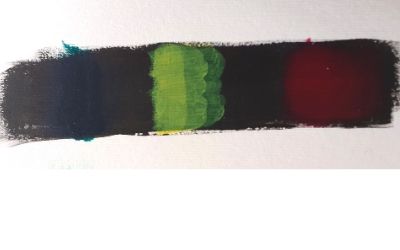
I used the following paints again.
- Phthalo green (t)
- Lemon Yellow (t)
- Quinacridone violet (t)
As you can see from this example adding layer over layer of paint does make it increasingly more opaque.
I used only three layers here and already the yellow is becoming a lot less transparent. The first layer is on the right and as they come to the left more paint is added.
Another thing that is noticeable is that the underneath layer color can affect the number of layers needed even if all are transparent. If you look at the green over the black it is barely showing even after three layers.
6 Swap Your Paint Color Brand
Not all brands have the same color opacity for the same colors. You can swap one color for the same color in a different brand. Whether this works will depend on the color. I have given more detail under the title below – Which Acrylic Paints Are Opaque? But a good example is my cobalt blue which is opaque compared to Golden Open acrylics which cobalt blue is transparent 5 on a scale of 1 to 8. With 8 being completely transparent.
7 Paint Dilution Makes A Difference
Use your paints undiluted. Although it doesn’t make a transparent color opaque it is stronger than if you dilute it with water or acrylic mediums. Combine that with an opaque, semi-opaque, or a touch of white and your color will be much more opaque and needless layers. The more diluted your color is the more transparent it becomes.
8 Use Artist Or High Pigment Paints
If you use better quality or artists’ acrylic paint it has a higher pigment quantity in it. This makes the color more intense and covers the base layer better. I don’t make your paint opaque as is evidenced by my phthalo green in the examples above. It does mean that when the other techniques are used it is easier to create a color that covers better with fewer layers. This does depend on the base color.
Don’t rush out and buy expensive artists’ acrylics though as you can see from my lemon yellow (also above) even the budget student/artist ranges can cover very well using different
I thought this video by Ivy Lily Creatives gave some clear and simple examples of some of the methods I have already discussed here.
Are Acrylic Paints Opaque?
Some acrylic paints are opaque. However, most acrylic paints are either transparent or semi-transparent. This can vary a lot from brand to brand.
Acrylics are designed to act like they are oil and add in layers so it is an advantage for them to be transparent or semi-transparent. In my view, their transparency is why they make such a great watercolor substitute as well.
Some brands do opaque ranges of color, but at the time of writing these are only high flow acrylics.
Which Acrylic Paints Are Opaque
The pigments in the acrylic paint vary in transparency. This is why some paints are more opaque than others. It can also depend on whether a natural or artificial pigment has been used.
There is a certain amount of variance as to how opaque or transparent a color is depending on the brand or the pigment used.
There are a few challenges with putting a list together saying a specific color is opaque, transparent, or semi-transparent. That is, what is true of a color paint in one brand is not in another.
Here are some examples of the issue.
- Titanium White – is usually opaque
- Cobalt Blue (system 3) is opaque, Note here other brands like Golden Heavy bodies are virtually transparent.
- Yellow Ochre – opaque ( by Atelier natural iron oxide), (Yellow ochre Mattiese is transparent, it is synthetic). The Yellow Ochre (by Atelier) tube indicates it is opaque but their site says semi-opaque, (Golden heavy bodies yellow ochre is semi-opaque)
Here are some popular brand color charts. I took an example color from each of these brands below – Cadmium Orange. As you can see it varies a lot. This may not be the case for all colors but it’s worth noting.
- Golden – semi-opaque
- Matisse – Opaque
- Liquitex – Semi Transparent
- Daler Rowney – Opaque
- Winsor & Newton – Opaque
So if you are searching for opaque and it is not in your preferred brand it may be available in another brand.
Golden does a high Flow Acrylic paint range that is opaque.
This is also a good way to add opacity to your color mixing if you want to make your paint more opaque and you have a transparent color. It might not always work but it’s worth a look.
A quick way to tell opacity if you are shopping locally is to look at the tubes. Most tubes will have a symbol or letter saying how opaque or transparent they are.
Examples Of Manufactures Showing Opacity of Their Paint
Here are some examples of different brands taken from my tubes. Some are explained better than others.
Atelier Interactive
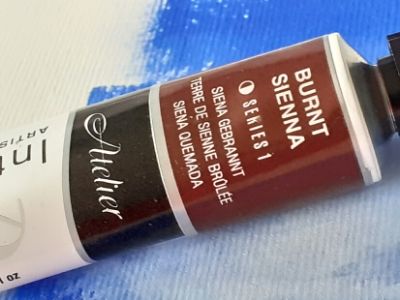
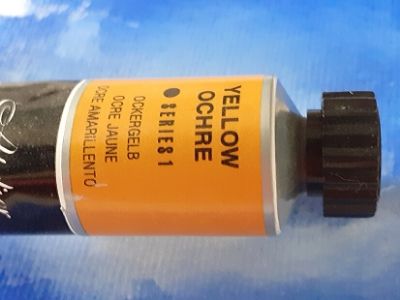
These are a nice simple way to tell how transparent or opaque the paint is. Although they are not as detailed as some of the others the simple circle blacked out, empty, or semi-full shows the transparency of the paint as you can see from the two examples above.
A word of warning though. The blacked-out circle should mean opaque yet can mean semi-opaque as in the case of the yellow ochre.
System 3 (Daler Rowney)

Again here is a nice simple and fast guide, as to the opaqueness of your paint. Here there is a simple permanence guide followed by the (t) for transparency.
Golden Heavy Body
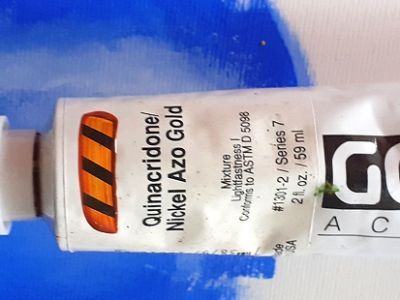
This is the clearest example of the color and how transparent it is. Golden use actual paint samples on their tubes. These along with black lines show you exactly how transparent or opaque the particular color is in their range.
Daler Rowney, Cryla Artist Color
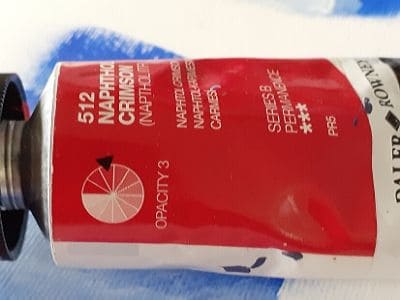
This method should you how transparent or opaque your paint is. It is also very clear but doesn’t give an actual paint example. Both the circle and the writing underneath it makes it very clear how opaque the paint is.
The best explanation on the tubes or opacity is in my view the Cryla and Golden with Cryla being immediately clear and more detailed than the others and Golden being both very clear and very detailed. Artists prefer actual acrylic paint examples painted on the tube as these give a better view of what the actual paint looks like. A printed color can vary giving a false idea of the color. There is a bar on the back of the tube with details of how opaque the paint is, its gloss, how thick it is, and high or low tinting.
What Is The Most Opaque Paint?
According to Winsor and Newton titanium white is the most opaque paint color. This is fairly standard across the brands. While titanium white is great to add to other colors for opacity it can make the colors go chalky and of course, it also changes the color the more you add.
Golden High Flow Acrylic Opaque Set is designed to be opaque. However, as they are high flow they are much more fluid than the usual tubed acrylic paints, much more like ink than high bodied paints.
What Opaque Paint Is
With acrylic paints, you get transparent paints, semi-transparent and opaque paints. Most are somewhere between the two extremes. Professional paint is graded much more finely than student paint.
When the paint is translucent it is because it lets the light through. You can see through it to the layer or layers below. This is used to great effect when painting and can alter the whole look of your paint.
When the paint is opaque it doesn’t allow the light to go through it and you cannot see the layers below. All the methods in this article are designed to reduce transparency and make your paint much less see-through and more opaque.
